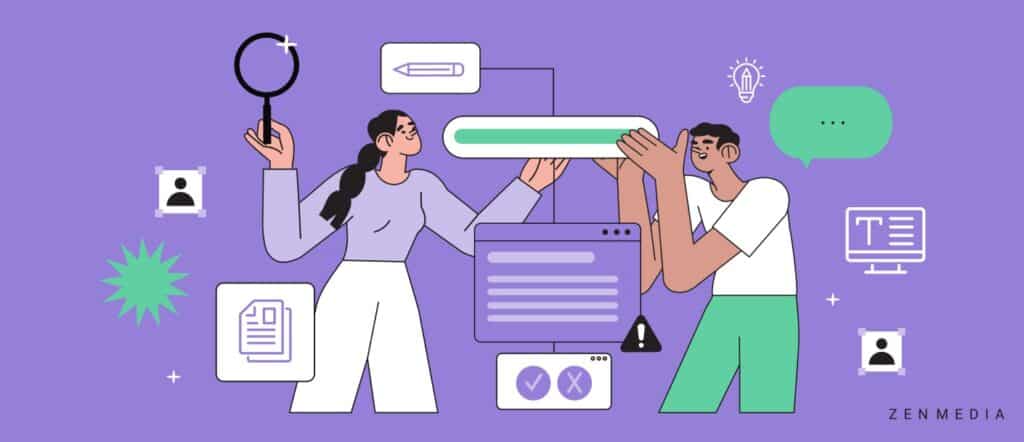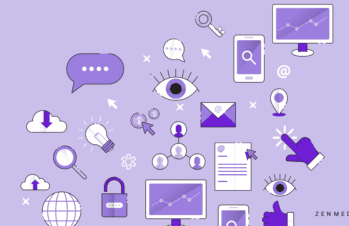Welcome to the future, where AI-generated content is becoming more and more prevalent. From news articles to social media posts, it’s getting harder to tell what’s been written by a human and what’s been spewed out by an algorithm.
As we all know, with great power comes great responsibility. While AI-generated content can save us time and effort, it also has the potential to produce robotic and unoriginal writing that can leave readers snoozing at their desks. Plus, with the rise of deep fakes and fake news, it’s more important than ever to be able to detect when a piece of content has been generated by AI.
Enter OpenAI, the company behind the ChatGPT language model. The company has just released a tool to identify AI-written content. Dubbed the “AI text classifier,” this tool promises to make it easier for businesses to ensure that humans, not machines, write their content. But how exactly does it work, what can it mean for your B2B marketing strategy, and is it really that reliable?
How does OpenAI’s AI Text Classifier work?
The AI Text Classifier went live on January 31st, 2023, and—like OpenAI’s other tools—is free to use. It works by analyzing the patterns in the text and comparing them to the patterns found in a large dataset of known AI-generated and human-written text, analyzing a wide range of writing styles, including news articles, academic papers, social media posts, and advertising copy.
Even though it’s impossible to detect AI-written text with 100% accuracy, it has the potential to be a valuable asset for ensuring the integrity of online content. OpenAI says its new AI Text Classifier can limit the ability to run automated misinformation campaigns, use AI tools for academic fraud, and impersonate humans with chatbots.
To understand how the tool works, it’s helpful to consider some key characteristics of AI-generated text. One of the most common features is a lack of coherence or cohesion, as AI models often struggle to create text that flows naturally and logically. Additionally, AI-generated text often contains errors or inconsistencies less likely to occur in human-generated text. Finally, AI-generated text may exhibit unusual patterns of repetition or lack of variation in sentence structure, as these models are often trained on large amounts of text data that may not accurately reflect the nuances of human language.
This new tool is designed to identify these and other features indicative of AI-generated text. It uses a combination of machine learning algorithms and natural language processing techniques to analyze various aspects of the text, including grammar, syntax, word choice, and tone. The tool then assigns a probability score indicating the likelihood that AI-generated the text. Individuals, organizations, or platforms can use this score to determine whether a piece of text is trustworthy or whether it may be the product of a malicious actor or algorithm.
But even OpenAI recognizes that their classifier is not fully reliable. The website reads, “In our evaluations on a ‘challenge set’ of English texts, our classifier correctly identifies 26% of AI-written text (true positives) as ‘likely AI-written,’ while incorrectly labeling human-written text as AI-written 9% of the time (false positives).” It can also be evaded with minor edits.
For these reasons, the AI Text Classifier should not be the sole evidence used when deciding whether AI generated a document. Here are some other indicators you should consider when deciphering whether content is AI- or human-written.
How to identify AI-written content
Look for inconsistencies in language and tone.
One of the most significant challenges with AI-generated content is that it often lacks the natural flow and variation of human language. When AI algorithms generate text, they tend to rely on predefined patterns and formulas, resulting in content that can feel stiff and repetitive. This can be especially noticeable in longer pieces of content, where the lack of variation can become more apparent.
In addition to the tone of the content, the language used can also be a clue as to whether it was generated by AI. For example, AI-generated content may use vocabulary or grammatical structures that are unusual or inconsistent with typical human writing. By paying attention to these inconsistencies, you can better spot AI-generated content and distinguish it from content written by humans.
Check for repetitive or formulaic content.
Another common trait of AI-generated content is that it can be repetitive or formulaic, resulting in content lacking originality and creativity. If you notice that the content you’re reading is overly repetitive or follows a predictable formula, it’s possible that it was generated by AI.
One way to check for repetitive or formulaic content is to look for patterns in the writing style or structure. For example, if you notice that every sentence follows the same structure or that certain phrases are repeated throughout the text, it could be a sign that AI generated the content.
Another way to check for repetitive content is to use plagiarism detection tools. Many AI algorithms rely on pre-existing content as a basis for generating new text. By running the content through a plagiarism checker, you can see if the text has been copied or closely paraphrased from other sources.
However, it’s important to keep in mind that not all repetitive content is necessarily generated by AI. Some types of content, such as technical manuals or legal documents, may follow a predictable format due to industry standards or regulatory requirements.
Examine the context of the content.
When trying to identify AI-generated content, it’s important to consider the context in which the content appears. This means looking at the topic of the content, the intended audience, and the level of expertise required to write the content.
AI-generated content is often used for simple or straightforward topics that don’t require a lot of expertise or knowledge. For example, you may come across AI-generated content in product descriptions, news summaries, or social media posts. These types of content don’t typically require a deep understanding of the topic, and, because of this, AI algorithms can produce them with relative ease.
On the other hand, if you come across content that discusses complex topics or uses technical language, it’s less likely to be AI-generated—or at least it would’ve been heavily edited by a human. This is because AI algorithms may struggle to understand the nuances of these topics, and as a result, may not be able to generate accurate or informative content.
In addition to the topic of the content, it’s also important to consider the intended audience. If the content targets a specific group of people, such as medical professionals or legal experts, it’s less likely to be AI-generated. AI algorithms may not have the necessary expertise to write content that is tailored to specific audiences.
Verify sources and citations
AI algorithms generate content by pulling information from pre-existing data sources, and these sources may be outdated, unreliable, or even fake. Many AI platforms, like ChatGPT and perplexity.ai, provide the sources they use to generate content, so the human behind the AI can fact-check and/or include citations. Still, articles generated by AI are often missing the sources used, and when those sources are provided, they are often outdated or provided by a biased source.
Looking at the sources can help you determine if the piece may be AI-generated, and—more importantly—it can help you determine if the content of the piece is accurate, biased, and/or relevant.
Take the time to verify the sources and citations used. Look for reputable sources that are well-known and respected in their respective fields. Check to see if the sources cited are up-to-date and whether they support the claims made in the content.
Another thing to keep in mind is the credibility of the author or organization that produced the content. Look for information about the author or organization and check their credentials. Does the piece cite an extremely biased personal blog, or does it cite a study from a respected research organization?
By taking the time to verify the sources and citations used in the content, you can potentially identify if it was written by AI—and more importantly—you can ensure that you’re reading accurate and reliable information. This is particularly important when it comes to industries that can have a significant impact on people’s lives, such as health or finance.
How to use AI responsibly in B2B marketing
It’s clear AI has transformed B2B content marketing, enabling businesses to personalize customer experiences, analyze data more effectively, and automate processes. However, AI must be used responsibly to build trust with buyers. As buyers become more skilled at recognizing AI-generated content, it’s important to create content that is trustworthy, transparent, and authentic.
Do’s:
- Be transparent. Clearly indicate where AI is used and what it does. Avoid using AI to generate fake reviews or testimonials, or to mislead buyers.
- Use AI for data analysis. AI can help analyze large amounts of data to provide insights that can help inform marketing strategy but make sure to interpret the results correctly and avoid misleading conclusions.
- Use AI to personalize content. AI can help personalize content for consumers, but make sure the content is relevant and meaningful.
- Use AI to automate repetitive tasks. AI can automate repetitive tasks such as sending emails for B2B email marketing, social media scheduling, and lead generation, freeing up time for marketers to focus on more strategic initiatives.
- Monitor AI-generated content. Ensure AI-generated content is accurate, consistent, and relevant to the target audience.
- Use AI to streamline content production. AI is a great ideation tool, especially for content marketing. Leverage AI as a research tool for content marketing, and then use your human skillset and sensibilities to make that content engaging, unique, and relevant.
Don’ts:
- Don’t use AI to create fake personas or manipulate buyer data.
- Don’t use AI to generate spam or low-quality content. While consistency is an important part of marketing, in the end, your marketing content won’t succeed if it’s irrelevant or unhelpful to the buyer.
- Don’t rely solely on AI-generated content. Human input and creativity are still necessary for creating compelling and engaging content.
- Don’t use AI to write your content in a crisis or critical moment. In crisis comms, or in cases where the message is sensitive, make sure a human is in control of the messaging.
- Don’t ignore ethical considerations. AI can reinforce biases and perpetuate discrimination if not used responsibly. Ensure your AI systems are designed to be fair and unbiased.
- Don’t forget the human touch. Even though AI can be used to personalize content, nothing beats genuine human interaction. Use AI to enhance the buyer experience but also provide opportunities for human interaction when appropriate.
Being able to identify AI-generated content is more important than ever before. It allows us to make informed decisions and avoid potentially misleading or false information. Whether we’re reading news articles, product reviews, or educational content, being able to distinguish between AI-generated and human-generated content is crucial.
Being able to identify the difference will also help you better understand how to use ChatGPT effectively in your own marketing, B2B PR, and comms strategies.
Need help generating accurate, engaging content that doesn’t sound AI generated? Let’s chat.





